The SEIKO World Time "Atlas"
Model No. A239-5000, A239-5009, A239-5010, A239-5020 and A239-502A
In 1979 SEIKO introduced a new line of digital World Time watches using dual LCD modules.
In 1979 SEIKO released the A239 World Timer, one of the first wrist watches to use two separate LCD modules.
One screen displayed the time and day, the other displayed a map of the world with selectable time zone segments.
This model does not have a direct predecessor or successor, and is somewhat unique in the line of digital World Time watches from SEIKO.



There are many different versions of this watch to unpack, including:
- Versions marked WORLD TIME (5020 and 502A) and others marked WORLD TIMER ALARM (5000, 5009 and 5010) on the case, below the dial
- Dial Frames in blue, black and red
- Map LCD panels in green, black and red
- Cases in Stainless Steel and Gold-tone
- Two different bracelet styles
- And 5 different sub-model numbers: 5000, 5009, 5010, 5020 and 502A
Table of Contents
- Key Statistics
- Top-Line Sales Info
- Case Specs
- General Information
- Correct, Original setups by Model No
- Dial Features
- The Case
- Measurements
- Dial Frames
- Bracelets
- Production Numbers
- Resale Value
- Other Resources
- Video on how to use the watch
- Related Articles
Key Statistics
33mm
Watch Case Size w/o Crown
39mm
Lug to Lug Measurement
Common
Rarity Index Among Cataloged Examples is 0.0 out of 10
73
Total Examples Cataloged
38.4%
Percentage of all Cataloged Digital Examples
Top-line Sales Info
- 33mm case (not including buttons)
- 39mm lug to lug
- 19 selectable Time Zones
- Home time and calendar display: Hour (12 hour indication), minute, second, AM, PM and day of the week. At push of a button, month and date replaces seconds.
- World time and calendar display: Hour (12 hour indication), minute, AM, PM, time zone indicators and world map. Time and calendar can be displayed for any of the available world times
- Alarm Display: Hour (12 hour indication), minute, second, AM, PM and home or world time alarm mark. The alarm can be set to ring at any desired hour or minute in either the home time or the selected world time.
- Alarm Signal: The alarm rings twice every second in the home time and 3 times every second in the world time
- Time Signal: Can be set to ring every hour, on the hourBuilt-in illumination system
- +/- 15 seconds per month accuracy (3 minutes per year)
- Offered in Stainless Steel and Gold-tone versions
- MSRP: 45,000 YEN / $215 USD in Stainless Steel
- MSRP: 48,000 YEN / $275 USD in Gold-tone
General Information
The first thing you will notice when you have this watch in hand is just how small it is. Measuring a very narrow 33mm from side to side (excluding buttons), it is about 4mm narrower than the PAN AM (M158-500X). That may not sound like much, but it is very noticeable. Like the other watches in this generation, it has hooded lugs, with a lug to lug measurement of 39mm - that is measuring top to bottom.
Correct, Original setups by Model No
Using Casing Guides from the early 1980's we are able to correctly match model numbers to the case finish, LCD color, dial frame and bracelet. This breaks down as follows:
A239-5000 and A239-5009
- Case marked WORLD TIMER ALARM
-
Stainless Steel Finish
- Black Dial Frame
- Black Map LCD
- Z330 Bracelet
-
Gold-tone Finish
- Brown Dial Frame
- Red Map LCD
- Z330 Bracelet in Gold-tone
A239-5010
- Case marked WORLD TIMER ALARM
-
Stainless Steel Finish
- Blue Dial Frame
- Green Map LCD
- Z330 Bracelet
- No Gold-tone Finish Version for this Model
A239-5020
- Case marked WORLD TIME
-
Stainless Steel Finish
- Black Dial Frame
- Black Map LCD
- GA950 Bracelet
-
Gold-tone Finish
- Brown Dial Frame
- Red Map LCD
- GA950 Bracelet in Gold-tone
A239-502A
- Case marked WORLD TIME
-
Stainless Steel Finish
- Blue Dial Frame
- Green Map LCD
- GA950 Bracelet
- No Gold-tone Finish Version for this Model
It is not rare to find examples for sale that have swapped LCD modules and perhaps have incorrect LCD color and or dial frame for the specific model number.
Dial Features
The world cities are arranged in counter-clockwise order, unlike the other digital world timers produced by SEIKO. This places GMT on the bottom side of the dial frame, instead of the top. The timezone for local and away times is set via the map LCD, and indicated both with a marker next to the selected reference city and with a blinking segment of the world map. The "..." time zone allows you to set another offset if you cannot find what you want with the included list of cities.
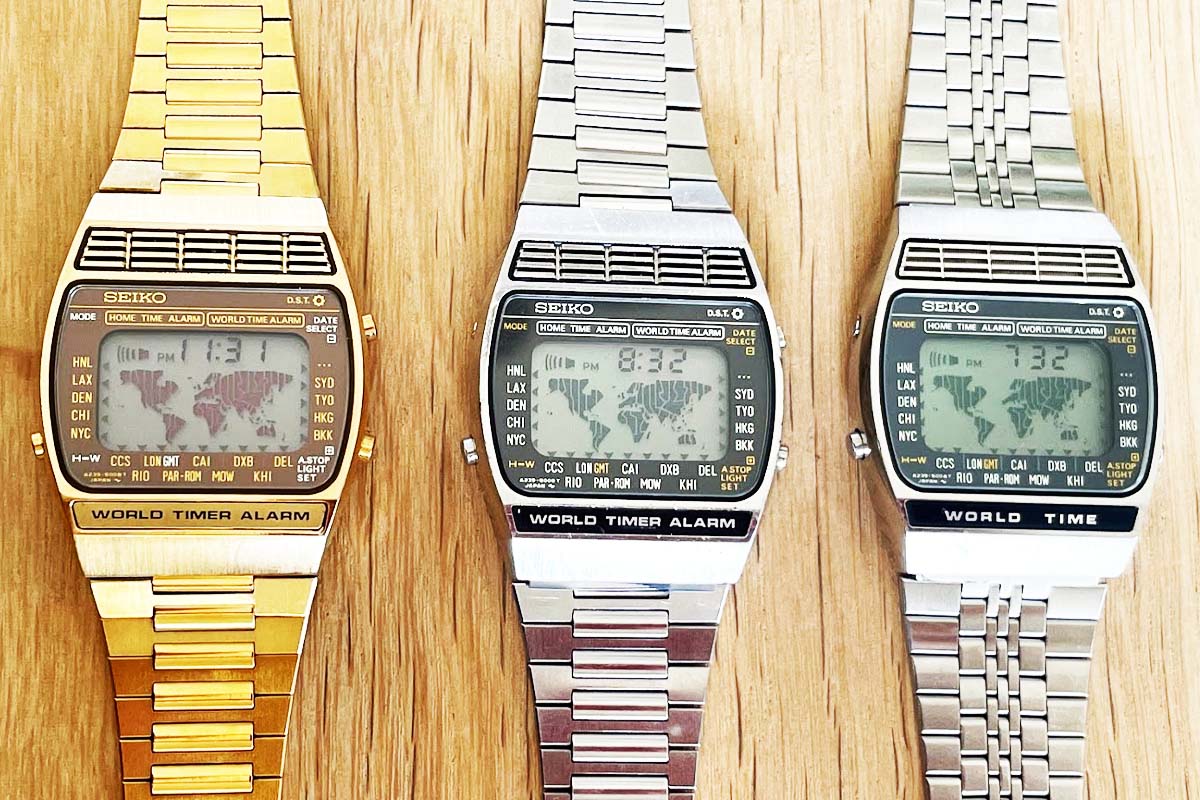
The Case
There are two different cases used on these watches. The 5000, 5009 and 5010 use one case design, the 5020 and 502A use an alternate design. The most obvious differences are:
- WORLD TIME vs WORLD TIMER ALARM under the dial
- The speaker grill design
- And the sub-model correct bracelet
- The case back design, once open





Measurements
Here are approximate measurements.







Dial Frames
Here are the three different dial frames.
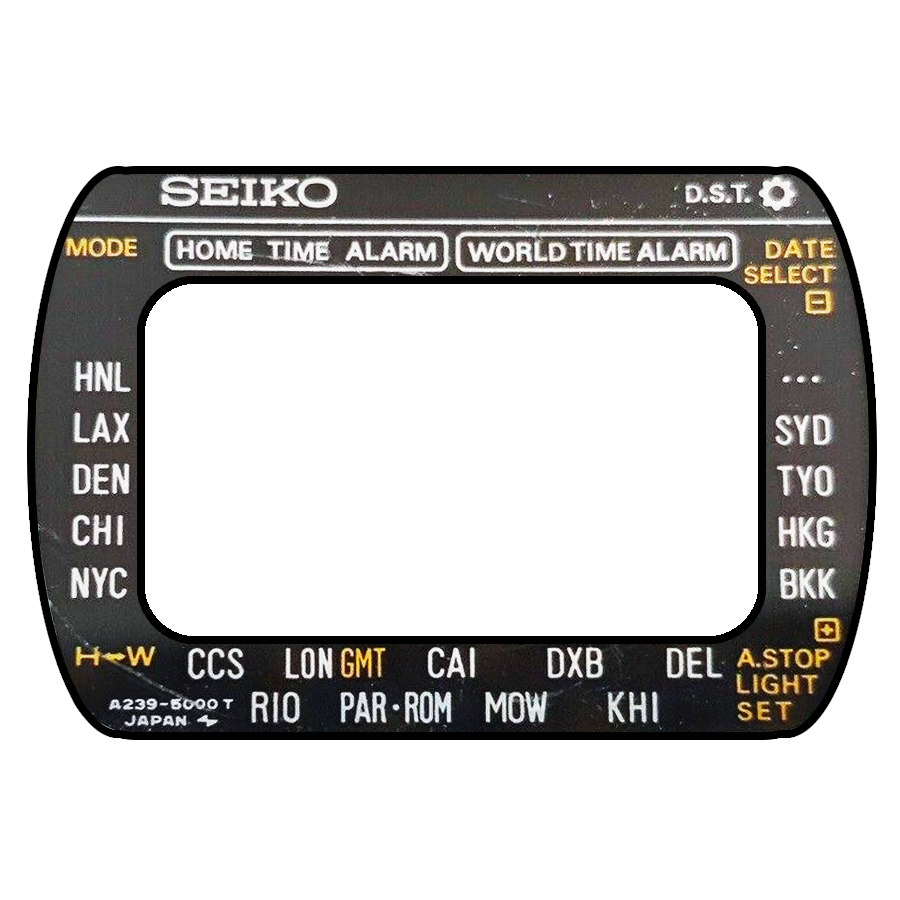
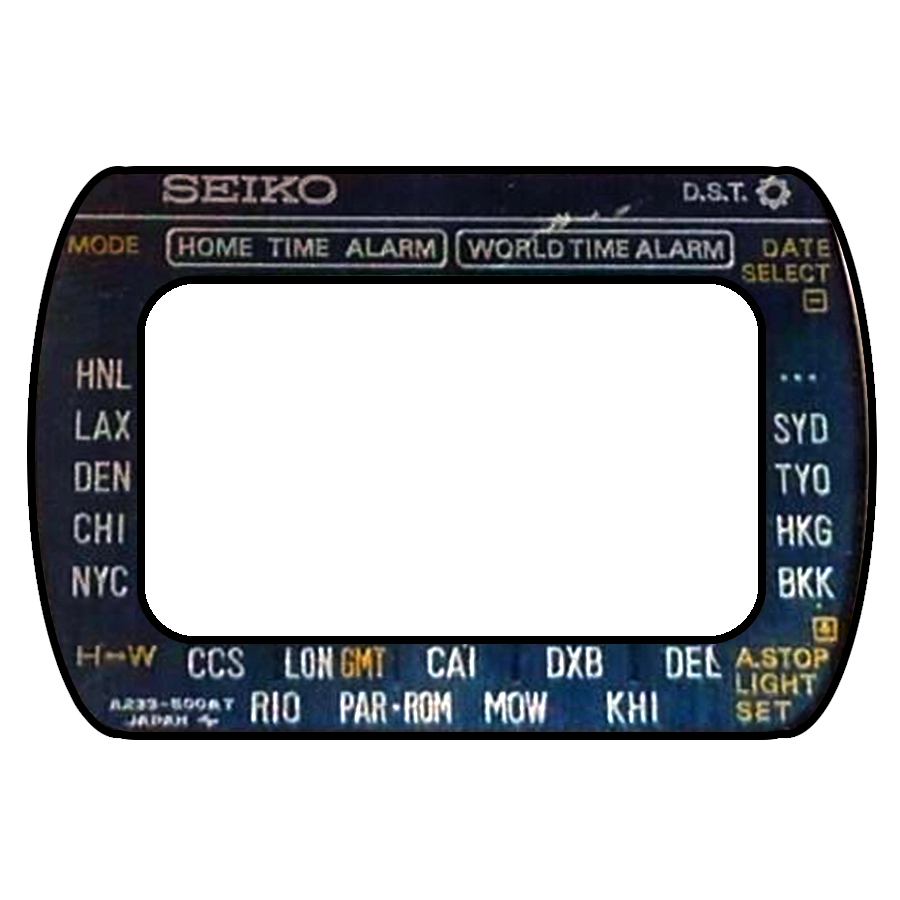
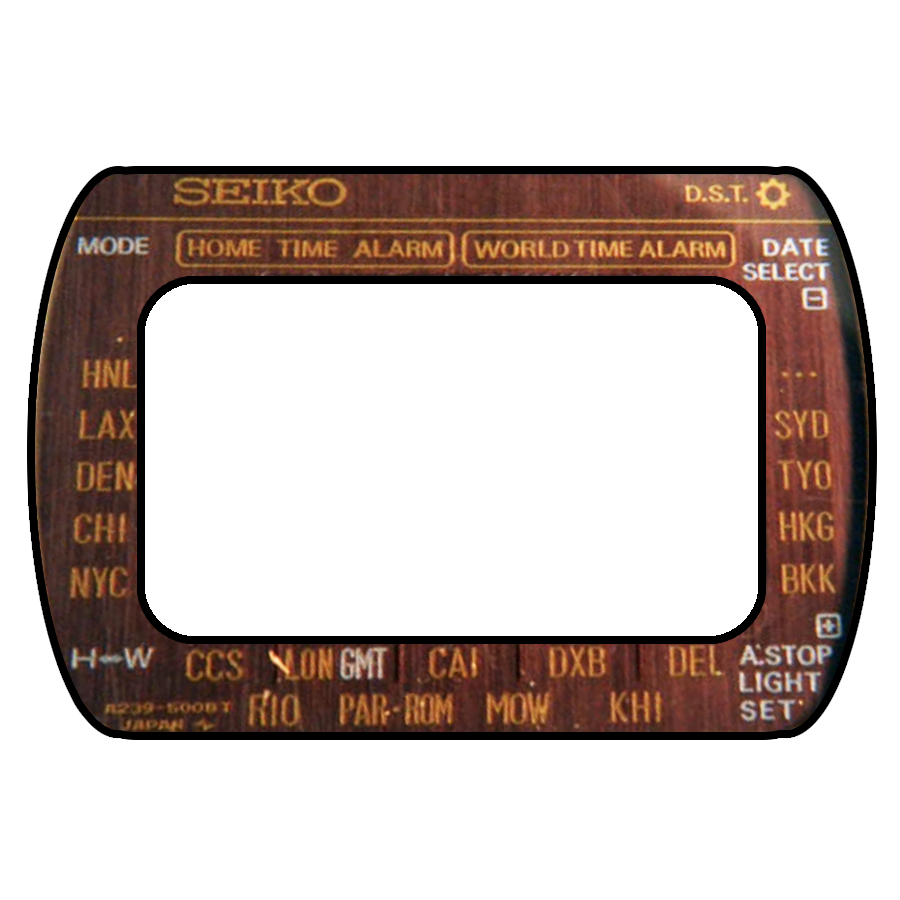
Original Bracelets
Z330
This bracelet forgoes removable links, instead using a sliding clasp on one side to allow for adjustment. Excess bracelet is tucked against the wrist. This style was produced in both stainless steel and gold-tone finishes.






The GA950 bracelet
The 5020 and 502A sub-models shared the GA950 bracelet, in both stainless steel and gold-tone finishes.






Production Numbers
Based on the image data collected to-date, this series was produced from at least November 1978 through at least August 1980. These models use a 6-digit serial number scheme, allowing for up to 9,999 watches per production month/year. Assuming a 22 month production run, this allows for a max production of 219,978 watches, with a minimum production of 56,514 based on current image data.
Resale Value
Please note:
- This scale is a derivative of the Hagerty Classic Car Condition Rankings, adapted for watches. It is an attempt to keep it simple. They explain it really clearly here (albeit in car terms): Car Conditions: What The Numbers Mean.
- Almost no one owns or has even seen a condition 1 example of this watch in at least a few decades. Most of what is sold online today are condition 4 and 5 watches - if you think you have a gem, it is most likely a 3.
- While many enthusiasts spend inordinate amounts of time chasing down the best deal, digging through the dark corners of the internet, local antique shops and estate sales, and are ok fixing things up themselves... a lot of others would like to just know what a clean example is worth from a reputable source - that's what these are. Think of them as the price you would expect to pay if you saw one of these under the glass at your favorite local watch shop.
- All values assume OEM parts or all original examples. After market dials, mismatched bracelets etc will reduce the value, in some cases substantially. For example a non-original bracelet can reduce the overall value by 10-20%, a non-original dial may reduce resale value by 80% or more.
- Finally, gold-tone variations (these are not gold plated, but rather gold colored base metal) command a much lower resale value, from 50% to 80% less than equivalent examples in stainless steel.
| Rank | Description and Value |
|---|---|
1 |
Condition 1
A perfect original (NOS) that has been professionally serviced and where all components are functioning as new; also a watch that has been restored to current maximum professional standards of quality in every area, showing no signs of wear; a 95-plus point show piece that isn't worn.
|
2 |
Condition 2
Well-restored or a combination of superior restoration and excellent original, where any replacement parts are strictly OEM; also, an extremely well-maintained original showing very minimal wear, or NOS that has not been professionally serviced.
|
3 |
Condition 3
Completely operable original or "older restoration" showing wear; also, a good amateur restoration, all presentable and serviceable inside and out. Plus combinations of well-done restoration and good operable components or a partially restored watch with all parts necessary to complete a restoration and / or valuable NOS parts.
|
4 |
Condition 4
A wearable watch needing no work to be functional; also, a deteriorated restoration or a poor amateur restoration. All components may need restoration to be "excellent", but the watch is usable "as is".
|
5 |
Condition 5
Needs complete restoration; may or may not be running, but isn't rusted, wrecked or stripped to the point of being useful only for parts.
|
6 |
Condition 6
May or may not be running, but is weathered, wrecked and/or stripped to the point of being useful primarily for parts.
|
Other Resources
The Internet is littered with various documents about this watch. Here is a quick collection to save you some googling around.
- Jules Borel parts list for movement - A239A
- Jules Borel parts list for watch and case - A239-5000
- Jules Borel parts list for watch and case - A239-5009
- Jules Borel parts list for watch and case - A239-5010
- Jules Borel parts list for watch and case - A239-5020
- Jules Borel parts list for watch and case - A239-502A
Video on how to use the watch
There are a few helpful how-to videos on YouTube. Here's one of them.
Related Articles
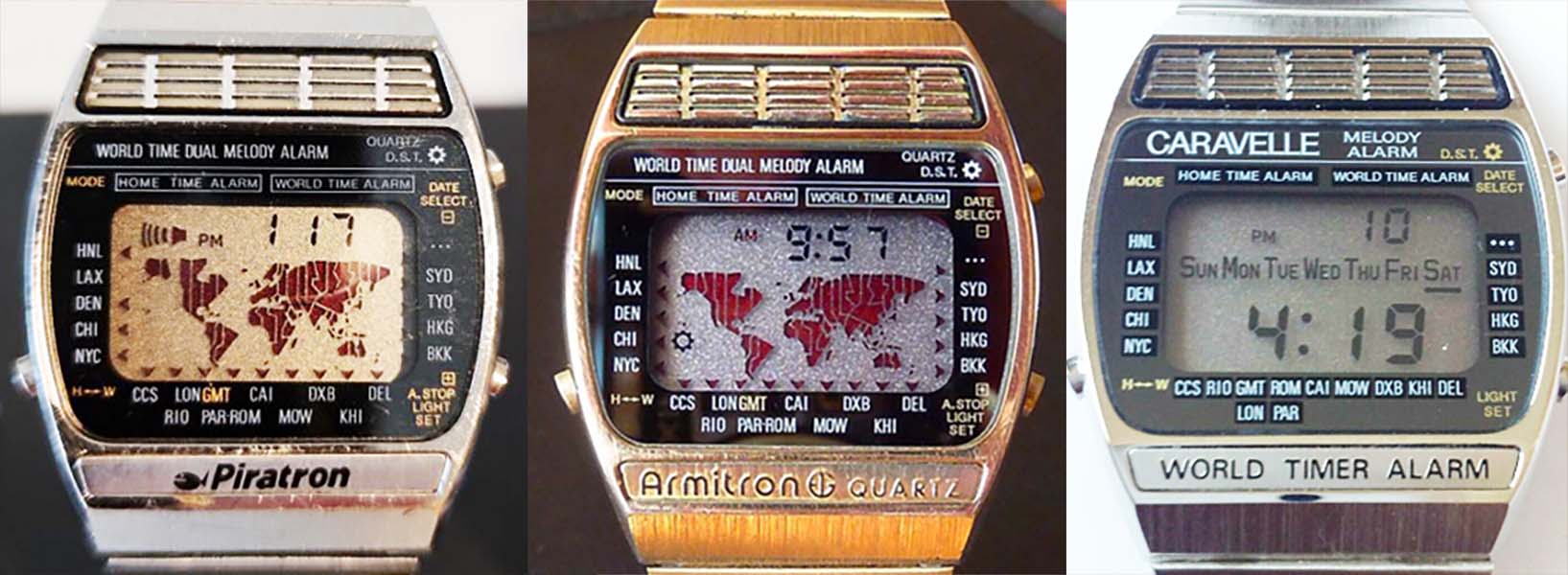
Counterfeits and Copies of The Seiko A239
As the saying goes, imitation is the highest form of flattery. And the SEIKO A239 had quite a few admirers.
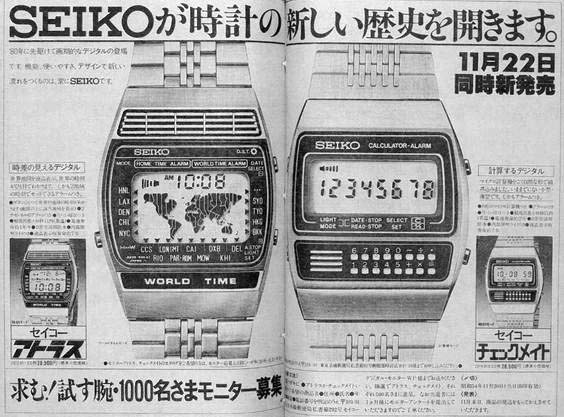
Old Ad Scans: Seiko World Time A239-50XX
A small collection of ad and catalog scans of the SEIKO World Time A239-50XX
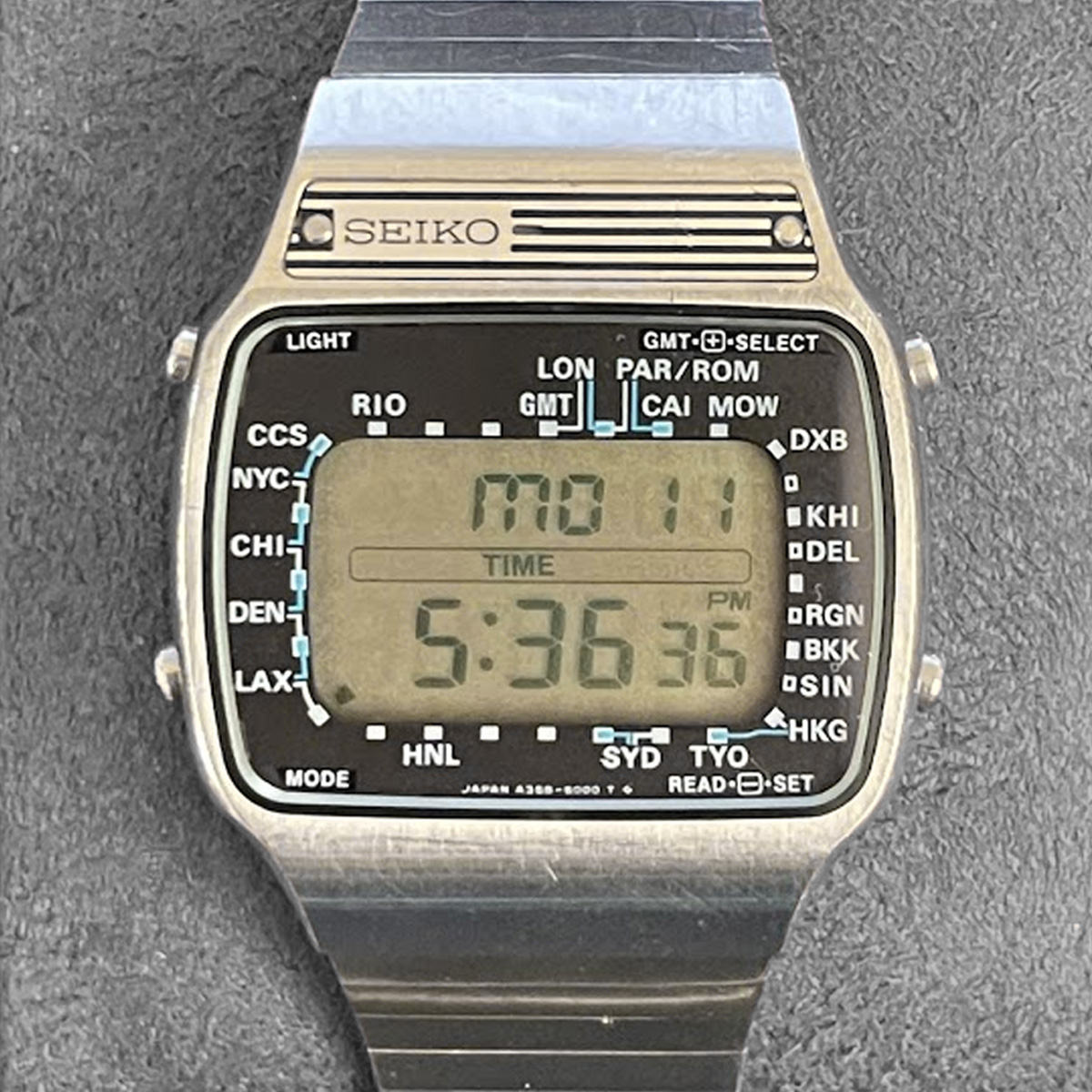
The Seiko World Time A358-500X - The Alarm
All about the 2nd series of digital LCD world time watch from SEIKO, produced in 1979
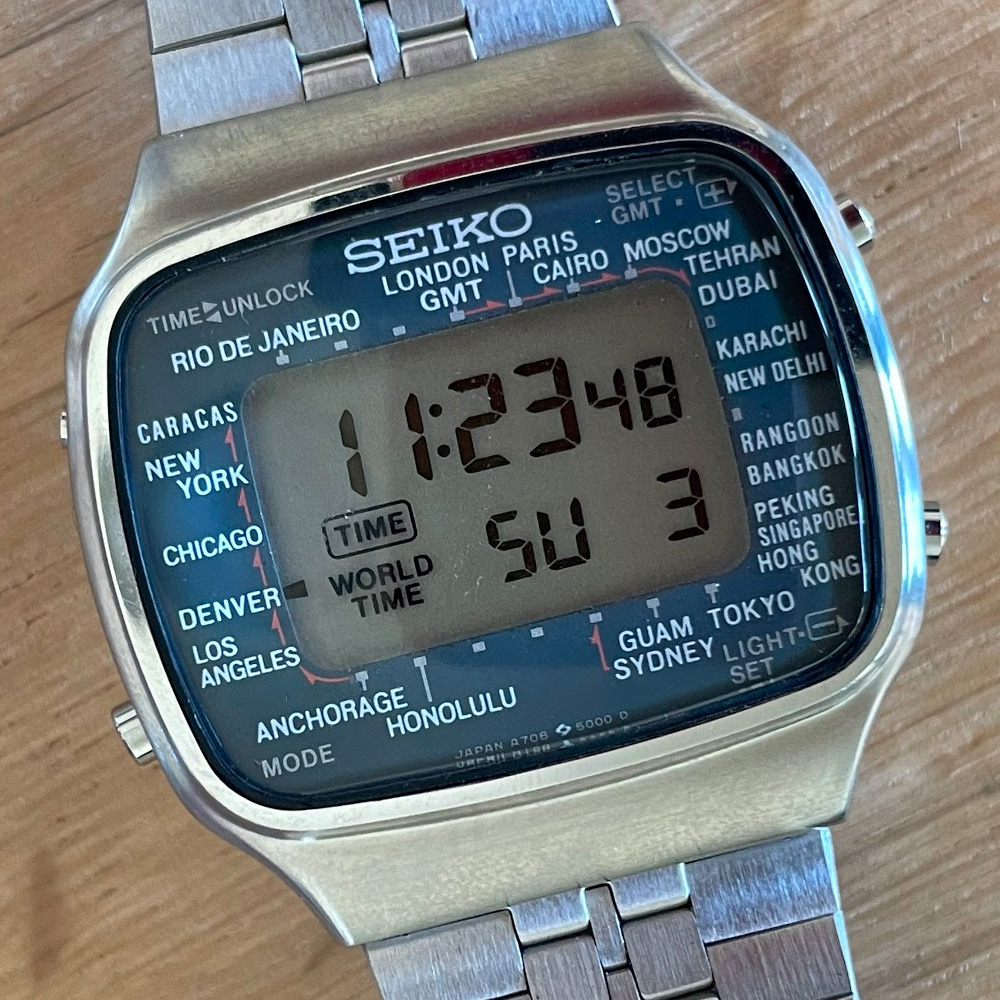
The Seiko World Time A708-5000 - The TWA
All about the 4th series of digital LCD world time watch from SEIKO, produced from 1984 through 1988
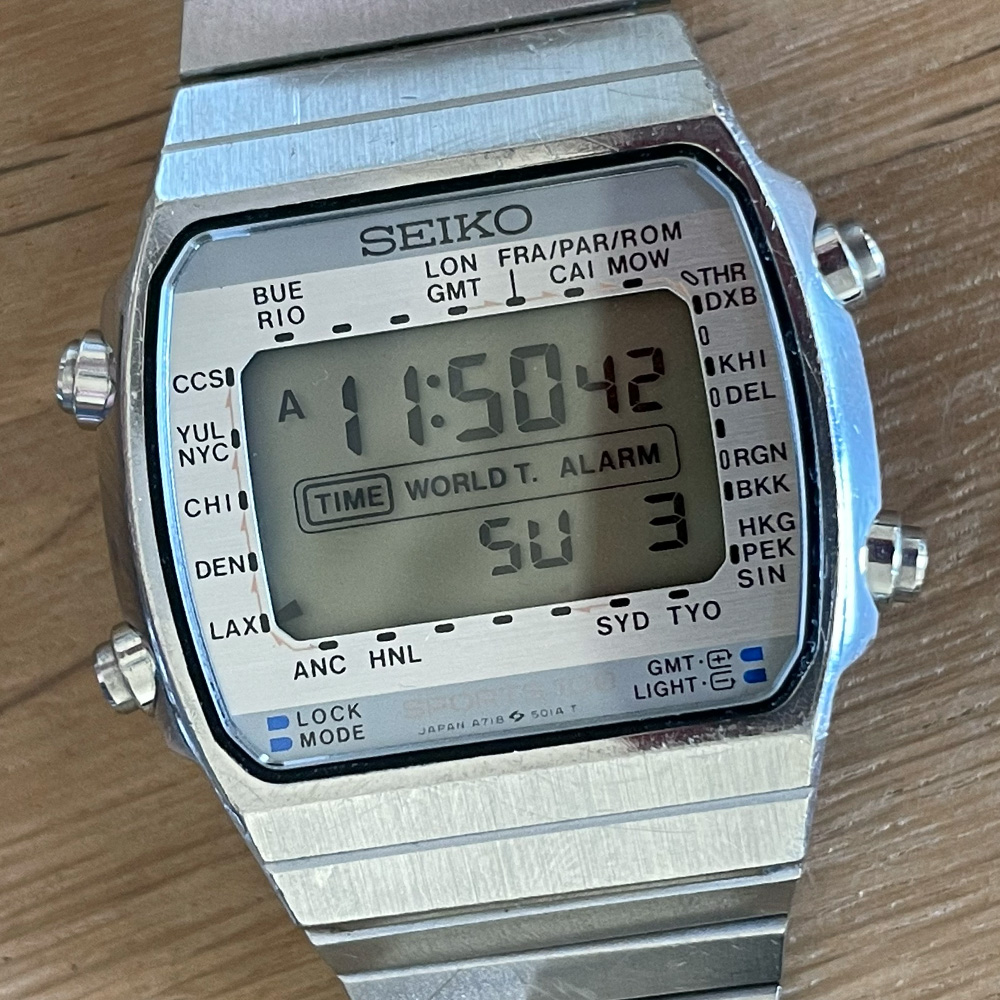
The Seiko World Time A718-5010 - The Frankenstein
All about the A718-5010 digital LCD world time watch from SEIKO, produced in 1984

The Seiko World Time A718-5030 - The John Cleese
All about the A718-5030 digital LCD world time watch from SEIKO, produced in 1984

Counterfeits and Copies of The Seiko M158 PAN AM
As the saying goes, imitation is the highest form of flattery. And the SEIKO M158 had quite a few admirers.
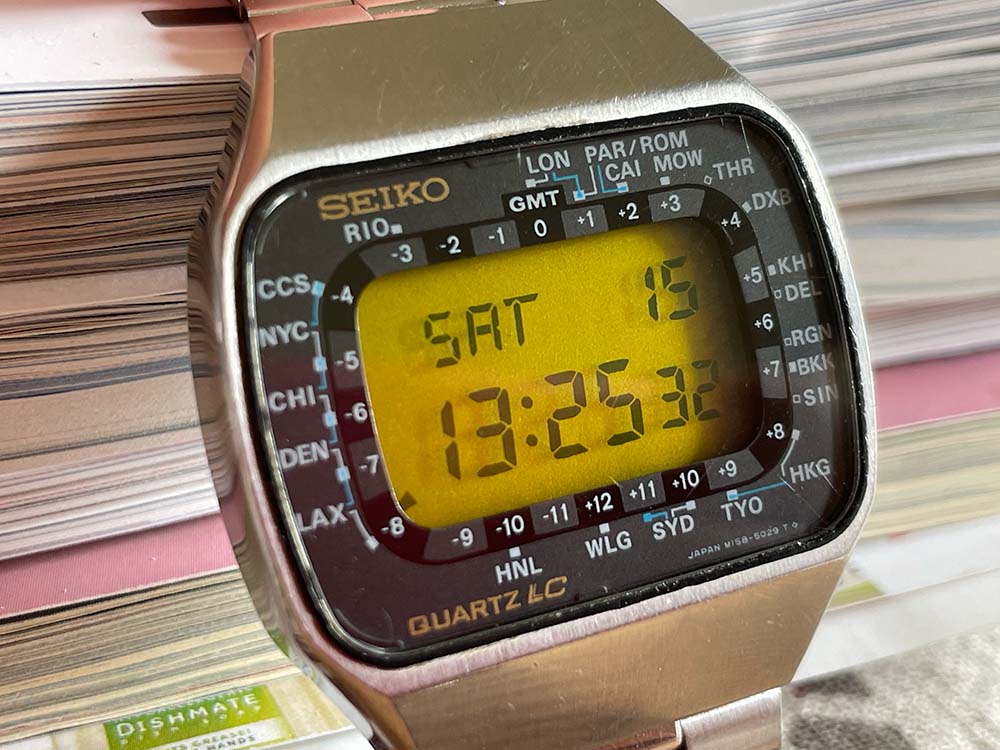
The Seiko World Time M158-500X - PAN AM
All about the 1st series of digital LCD world time watch from SEIKO, produced in 1977
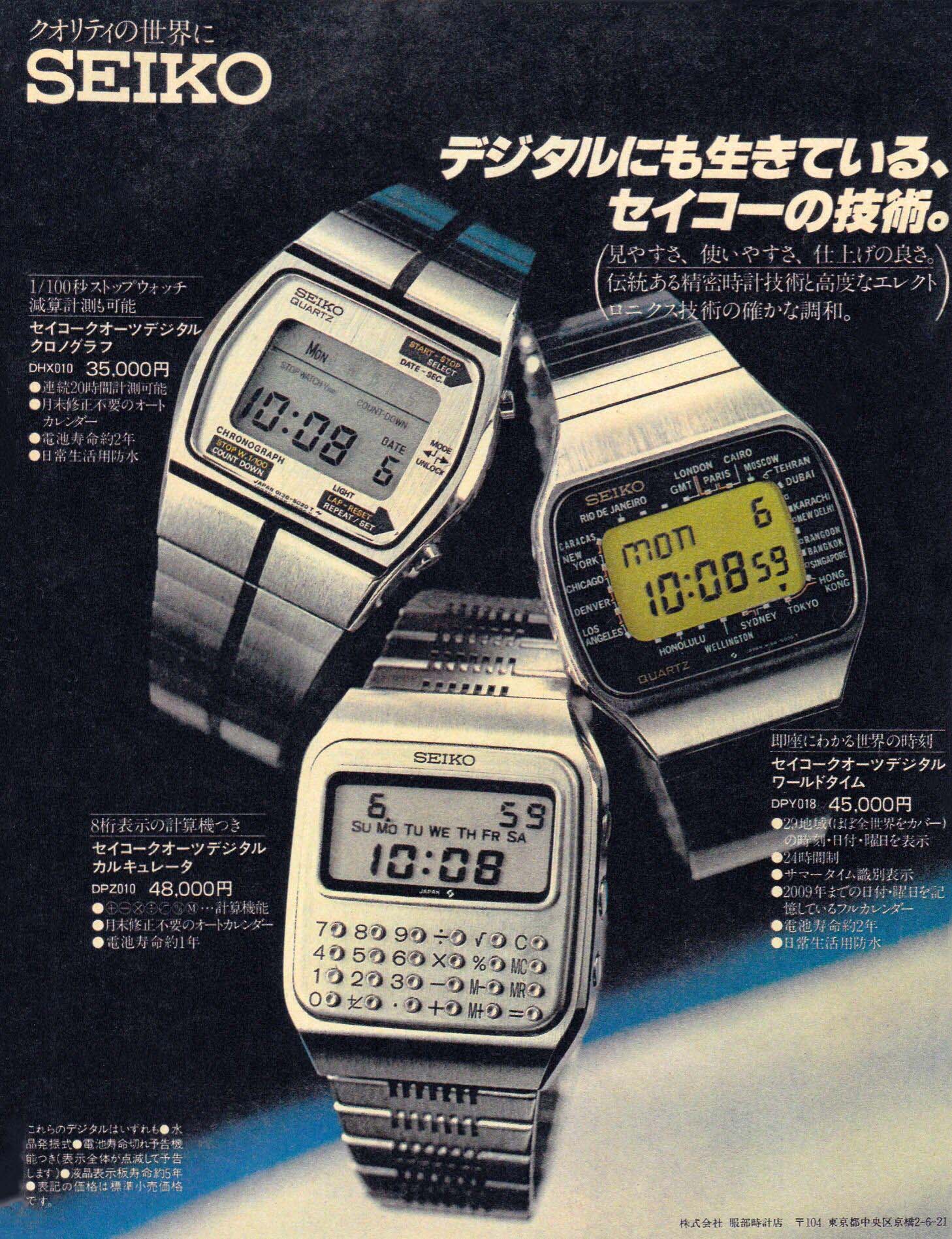
Old Ad Scans: Seiko World Time M158-500X
A small collection of ad and catalog scans of the SEIKO World Time M158-500X

Authenticating The Seiko World Time M158-500X
Tips on confirming the originality of your Seiko World Time M158-5000 and M158-5009
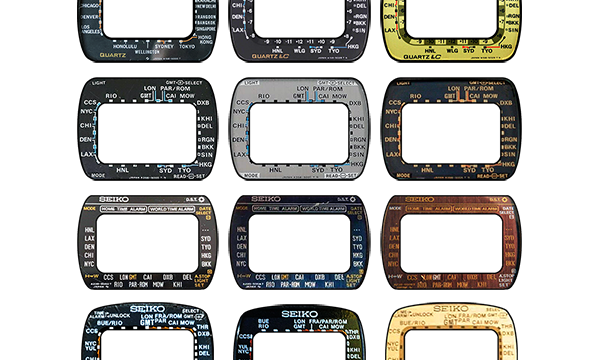
Reference Cities - Changes over the Years
A history of changes to the Cities Dial Frames on SEIKO World Time digital watches from 1977 through 1988

